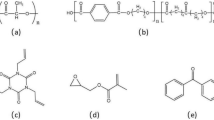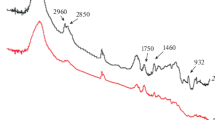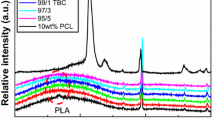Abstract
Composite materials prepared from polylactic acid have been used more and more widely in many fields. However, PLA has high brittleness, which largely restricts its application. Blending PLA with polycaprolactone (PCL) helps improve the disadvantages of pure PLA. In this study, different molecular weights of PCL were used and blended with PLA in different proportions to form a composite film by melt blending. The mechanical properties, thermal properties, and water wettability of Composite films are evaluated to examine the influences of the relative molecular weight of PCL and PCL/PLA ratio. When the relative molecular weight of PCL is 50,000, Composite films have high stress, strain, hydrophilicity, thermal properties, and UV-resisting property, but their thermal properties are not affected. At a specific relative molecular weight of PCL and PCL/PLA ratio of 30/70, the composite films reach their maximum stress and exhibit high strain, good hydrophilicity, and UV transmittance lower than 10%. Moreover, the PCL/PLA ratio has a marginal effect on the thermal properties of the composite films. This research has certain significance for promoting the application of PCL/PLA composite film in many fields.









Similar content being viewed by others
References
Correa-Pacheco ZN, Jimenez-Perez JL, Sabino MA, Cruz-Orea A, Loaiza M (2015) Photothermal and morphological characterization of PLA/PCL polymer blends. Appl Phys A Mater Sci Process 120:1323–1329
Chen JC, Chueh H, Tseng H, Huang SL (2003) Preparation and characterization of biodegradable PLA polymeric blends. BIOMATERIALS 24:1167–1173
Van deVelde K, Kiekens P (2002) Biopolymers: overview of several properties and consequences on their applications. Polym Test 21:433–442
Pantani R, Santis FD, Sorrentino A, Maio FD, Titomanlio G (2010) Crystallization kinetics of virgin and processed poly(lactic acid). Polym Degrad Stab 95:1148–1159
Koo H, ** G, Kang H, Lee Y, Nam H, Jang H, Park J (2009) A new biodegradable crosslinked polyethylene oxide sulfide (PEOS) hydrogel for controlled drug release. Int J Pharm 374:58–65
Park S, Lim S, Shin T, Choi H, Jhon M (2001) Viscoelasticity of biodegradable polymer blends of poly(3-hydroxybutyrate) and poly(ethylene oxide). Polymer 42:5737–5742
Tian H, Tang Z, Zhuang X, Chen X, **g X (2012) Biodegradable synthetic polymers: preparation, functionalization and biomedical application. Prog Polym Sci 37:237–280
Adhikari R, Bristow KL, Casey PS, Freischmidt G, Hornbuckle JW, Adhikari B (2016) Preformed and sprayable polymeric mulch film to improve agricultural water use efficiency. Agr Water Manage 169:1–13
Arrieta MP, Peponi L (2017) Polyurethane based on PLA and PCL incorporated with catechin: structural, thermal and mechanical characterization. Eur Polym J 89:174–184
Brooks T (1996) Method and apparatus of recycling previously used agricultural plastic film mulch. J Clean Prod 4:137–138
Choa JW, Chun BC, Park JS (2001) Ultraviolet reflective and mechanical properties of polyethylene mulching films. Eur Polym J 37:1227–1232
Cuello JP, Hwang HY, Gutierrez J, Sang YK, Kim PJ (2015) Impact of plastic film mulching on increasing greenhouse gas emissions in temperate upland soil during maize cultivation. Appl Soil Ecol 91:48–57
Chao JL, Fu JW, Grae HD, Ze Z, Robert G, Lu W (2017) Comprehensive mechanical characterization of PLA fabric combined with PCL to form a composite structure vascular graft. J Mech Behav Biomed Mater 69:39–49
Hayashi N, Ono R, Uchida S (2015) Growth enhancement of plant by plasma and UV light irradiation to seeds. J Photopolym Sci Technol 28:445–448
Christiane P, Marina R, Lyngstadaas SP, Ellingsen JE, Monjo M (2010) In vivo performance of titanium implants functionalized with eicosapentaenoic acid and UV irradiation. J Biomed Mater Res A 96:83–92
Lang Z, Zhongxing G, Weijun Z (2019) Preparation, characterization, and reaction kinetics of poly(lactic acid)/amidated graphene oxide nanocomposites based on reactive extrusion process. J Polym Res 26:78
Surya R, Sudheer K, Sushanta KS, Smita M, Sanjay KN (2018) PLA/ESO/MWCNT nanocomposite:a study on mechanical,thermal and electroactive shape memory properties. J Polym Res 25:126
Zehua Q, Juan B, **aoyue H (2018) Probing the nanomechanical properties of PLA/PC blends compatibilized with compatibilizer and nucleation agent by AFM. J Polym Res 25:138
Ivan K, Jaroslav K, Ludmila K (2016) Crystallization and thermal properties of melt-drawn PCL/PLA microfibrillar composites. J Therm Anal Calorim 124:799–805
Campos AD, Marconato JC, Martins-Franchetti SM (2011) Biodegradation of blend films PVA/PVC, PVA/PCL in soil and soil with landfill leachate. Braz Arch Biol Technol 54:1367–1378
Guarás MP, Alvarez VA, Ludueña LN (2015) Processing and characterization of thermoplastic starch/polycaprolactone/compatibilizer ternary blends for packaging applications. J Polym Res 22:165
Zafer U, Adile Ö (2018) Preparation of a star-type telechelic macrophotoinitiator of poly(ε-caprolactone) and its use in photoinduced free radical promoted cationic polymerization. J Polym Res 25:245
Broz M, Vanderhart D, Washburn N (2003) Structure and mechanical properties of poly(D,L-lactic acid)/poly(epsilon-caprolactone) blends. Biomaterials 24:4181–4190
Plackett D, Holm V, Johansen P, Ndoni S, Nielsen P, Malm TS, Dergard AS, VerstichelZ S (2006) Characterization of L-potylactide and L-polylactide-polycaprolactone co-polymer films for use in cheese-packaging applications. Packag Technol Sci 19:1–24
Chin SW, Hsin TL, Chi HT (2018) Polyester-based green renewable eco-composites by solar energy tube processing: characterization and assessment of properties. J Polym Res 25:240
Antonio JG, Joan S, Joaquim C (2017) Fabrication of PCL/PLA composite tube for stent manufacturing. Procedia CIRP 65:231–235
Chao**g L, Fujun W, Peifeng C, Ze Z, Robert G, Lu W (2017) Preventing collapsing of vascular scaffolds: the mechanical behavior of PLA/PCL composite structure prostheses during in vitro degradation. J Mech Behav Biomed 75:455–462
Karami Z, Rezaeian I, Zahedi P, Abdollahi M (2013) Preparation and performance evaluations of electrospun poly(ε-caprolactone), poly(lactic acid), and their hybrid (50/50) nanofibrous mats containing thymol as an herbal drug for effective wound healing. J Appl Polym Sci 129:756–766
Mittal V, Akhtar T, Matsko N (2015) Mechanical, thermal, rheological and morphological properties of binary and ternary blends of PLA, TPS and PCL. Macromol Mater Eng 300:423–435
Jain S, Reddy MM, Mohanty AK, Misra M, Ghosh AK (2010) A new biodegradable flexible composite sheet from poly(lactic acid)/poly(ε-caprolactone) blends and micro-talc. Macromol Mater Eng 295:750–762
**uhua L, Baolin H, **u Y, Ligong Z, Fangfang H (2016) The soil water dynamics and hydraulic processes of crops with plastic film mulching in terraced dryland fields on the loess plateau. Environ Earth Sci 75:809
Luyt AS, Gasmi S (2016) Influence of blending and blend morphology on the thermal properties and crystallization behaviour of PLA and PCL in PLA/PCL blends. J Mater Sci 51:4670–4681
Zefeng M, Yubo M, Lizhen Q, Jixiang L, Haijia S (2016) Preparation and characteristics of biodegradable mulching films based on fermentation industry wastes. Int Biodeterior Biodegradation 111:54–61
Nampoothiri KM, Nair NR, John RP (2010) An overview of the recent developments in polylactide (PLA) research. Bioresour Technol 101:8493–8501
Boubkeur SB, Abderrahmane H, Yves G, Isabelle P (2017) Organomontmorillonite/graphene-PLA/PCL nanofilled blends: new strategy to enhance the functional properties of PLA/PCL blend. Appl Clay Sci 139:81–91
Mostafa S, Majid S, Sara K, Ahmad O, Amir K, Babak S (2018) In vitro and in vivo investigation of PLA/PCL scaffold coated with metformin-loaded gelatin nanocarriers in regeneration of critical-sized bone defects. Nanomed- Nanotechnol 14:2061–2073
Roberto S, Francesco L (2018) Properties-morphology relationships in electrospun mats based on polylactic acid and graphene nanoplatelets. Compos Part A: Appl S 108:23–29
Mofokeng JP, Kelnar I, Luyt AS (2016) Effect of layered silicates on the thermal stability of PCL/PLA microfibrillar composites. Polym Test 50:9–14
Mobasseri SA, Terenghi G, Downes S (2014) Schwann cell interactions with polymer films are affected by groove geometry and film hydrophilicity. Biomed Mater 9:5
Navarro-Baena I, Sessini V, Dominici F, Torre L, Kenny JM, Peponi L (2016) Design of biodegradable blends based on PLA and PCL: from morphological, thermal and mechanical studies to shape memory behavior. Polym Degrad Stab 132:97–108
Qingqing Y, Jaqueline GLC, Tao X, Jacob MM, Paulo HSP, Hao F, Hongli S (2017) Three dimensional electrospun PCL/PLA blend nanofibrous scaffolds with significantly improved stem cells osteogenic differentiation and cranial bone formation. Biomaterials 115:115–127
Ostafinska A, Fortelny I, Nevoralova M, Hodan J, Kredatusova J, Slouf M (2015) Synergistic effects in mechanical properties of PLA/PCL blends with optimized composition, processing, and morphology. RSC Adv 5:98971–98982
Phromma W, Magaraphan R (2013) Morphology and mechanical properties of natural rubber-PCL Core-Shell/PLA composites. Adv Mater Res 747:745–748
Monticelli O, Calabrese M, Gardella L, Fina A, Gioffredi E (2014) Silsesquioxanes: novel compatibilizing agents for tuning the microstructure and properties of PLA/PCL immiscible blends. Eur Polym J 58:69–78
Takayama T, Todo M (2006) Improvement of impact fracture properties of PLA/PCL polymer blend due to LTI addition. J Mater Sci 41:4989–4992
Zhao N, Lv ZR, Ma J, Zhu CW, Li Q (2019) Fabrication of hydrophilic small diameter vascular foam scaffolds of poly(epsilon-caprolactone)/polylactic blend by sodium hydroxide solution. Eur Polymer 110:31–40
Vink ETH, Rábago KR, Glassner DA, Gruber PR (2003) Applications of life cycle assessment to NatureWorks polylactide (PLA) production. Polym Degrad Stab 80:403–419
Wachirahuttapong S, Thongpin C, Sombatsompop N (2016) Effect of PCL and compatibility contents on the morphology, crystallization and mechanical properties of PLA/PCL blends. Energy Procedia 89:198–206
Mohammed AK, Hanan M, Jürgen K (2018) Broadband magnetic composite energy harvester. Adv Eng Mater 20:1–10
Watanabe K, Yamada N, Takeuchi Y (2006) Oxidative DNA damage in cucumber cotyledons irradiated with ultraviolet light. J Plant Res 119:239–246
Acknowledgements
This work is supported by the Natural Science Foundation of Tian** (18JCQNJC03400, 18JCQNJC72600), the Natural Science Foundation of Fujian (2018 J01504, 2018 J01505), the Open Project Program of Fujian Key Laboratory of Novel Functional Fibers and Materials (Minjiang University), China (No. FKLTFM1710, FKLTFM 1722), and the National Natural Science Foundation of China (grant number 11702187). This study is also supported by the Opening Project of Green Dyeing and Finishing Engineering Research Center of Fujian University (2017001A, 2017001B, and 2017002B) and the Program for Innovative Research Team in University of Tian** (TD13-5043).
Author information
Authors and Affiliations
Corresponding author
Additional information
Publisher’s note
Springer Nature remains neutral with regard to jurisdictional claims in published maps and institutional affiliations.
Rights and permissions
About this article
Cite this article
Li, TT., Zhang, H., Huang, SY. et al. Preparation and property evaluations of PCL/PLA composite films. J Polym Res 28, 156 (2021). https://doi.org/10.1007/s10965-021-02439-8
Received:
Accepted:
Published:
DOI: https://doi.org/10.1007/s10965-021-02439-8




